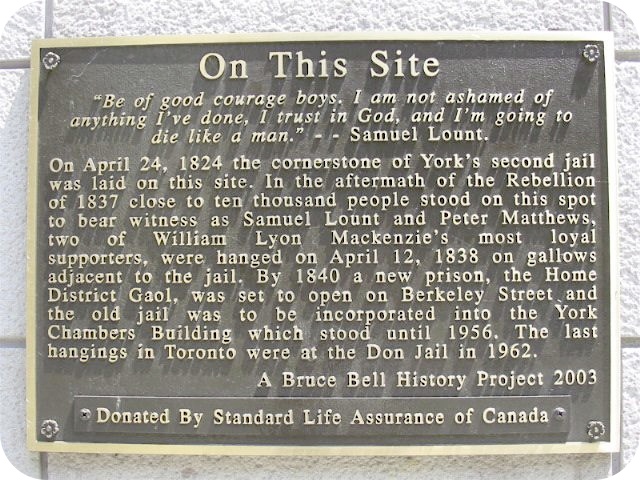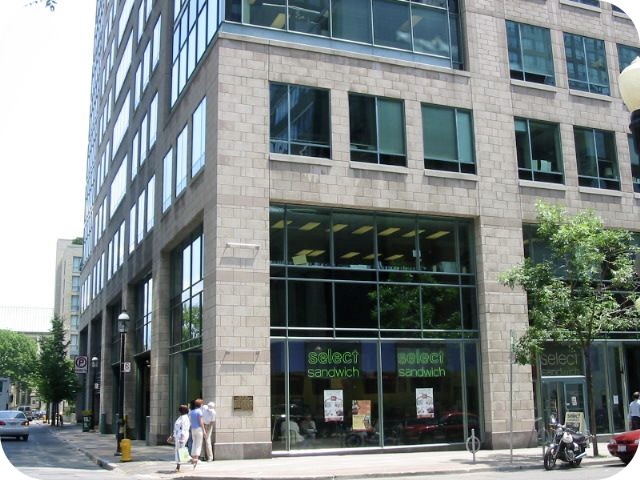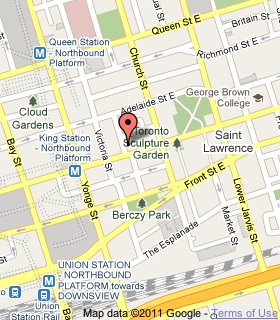Discover Toronto's history as told through its plaques
2004 - Now in our 15th Year - 2019
To see what's new on this site, you can visit the Home Page
Looking at this page on a smartphone?
For best viewing, hold your phone in Landscape mode (Horizontal)
Samuel Lount and Peter Matthews

Photos by Alan L Brown - Posted September, 2006

At the site of this building at 1 Toronto Street, at the corner with Court Street, the hanging of two of the participants in the Rebellion of 1837 took place. This 2003 Bruce Bell History Project plaque will give you the details:
Coordinates: 43.64982 -79.37589 |
 |
"Be of good courage boys, I am not ashamed of anything I've done, I trust in God, and I'm going to die like a man." - - Samuel Lount. On April 24, 1824 the cornerstone of York's second jail was laid on this site. In the aftermath of the Rebellion of 1837 close to ten thousand people stood on this spot to bear witness as Samuel Lount and Peter Matthews, two of William Lyon Mackenzie's most loyal supporters, were hanged on April 12, 1838 on gallows adjacent to the jail. By 1840 a new prison, the Home District Gaol, was set to open on Berkeley Street and the old jail was to be incorporated into the York Chambers Building which stood until 1956. The last hangings in Toronto were at the Don Jail in 1962.
Related webpages
Samuel Lount
Peter Matthews
York's second jail
The Rebellion of 1837
Related Toronto plaques
Patriots of 1837
David Gibson
Montgomery's Tavern
William Lyon Mackenzie
York Council Chambers 1907-1950
The Don Jail 1859-1864
More Bruce Bell History Project plaques
132 Front Street East
The Colborne Street Theatre
First Theatrical Performance
The Great Fire of 1849
Keating Coffee House
Rebellion of 1837
The War of 1812 & the Siege of York
West Market Street
York's First Jail
More
Conflict
Here are the visitors' comments for this page.
> Posted April 12, 2015
Today marks the 177th anniversary of the martyrdom of Samuel Lount and Peter Matthews, who so bravely fought for liberty against a British crown that sought to repress the People. Thousands petitioned the royal governor to spare their lives, even though signing it was an act of sedition. The foreman who was to supervise construction of the gallows refused to build it. But on the morning of April 12, 1838, Samuel Lount and Peter Matthews were hanged in public in downtown Toronto. Passing fellow prisoners on his way to the gallows, Lount is to have said, "We die in a good cause. Canada will yet be free."
In what has become an annual event to honour these patriots, a group will gather for an act of remembrance, this year at their final resting place at Toronto's Necropolis. Earlier, Mackenzie House museum will host a Rebellion walking tour.
-Wayne
> Posted March 28, 2015
In Thornhill, Ontario, a plaque relates how the Rebellion of 1837 divided even leading citizens, and how bonds of friendship trumped even one's convictions. It was erected in 1981 by the Society for the Preservation of Historic Thornhill, and is located on John Street at Confederation Way (43.814825, -79.422320). Here's what the plaque says:
"Richard Sutton Frizzell 1817 - 1876
Richard Frizzell, a Tory Loyalist active during the Rebellion of 1837, was disdainful of the rebel's cause. On October 18, 1837 he removed a 'Liberty or Death' flag from Gibson House and wove it into the tails of the rebels' horses outside. On December 4, noticing rebel movement on Yonge Street, Frizzell approached Benjamin Thorne, Thornhill's founder, for assistance. Thorne was reluctant to lend a horse as his Mill workers were mostly rebels, but he offered encouragement. After warning Sir Francis Bond Head at York (Toronto), Frizzell took part in the ensuing skirmishes but he refused to betray the location of his rebel friend Samuel Lount who was captured and hanged for treason."
-Wayne
> Posted April 12, 2012
These patriots were remembered at a ceremony today, at this site, on the anniversary of their hangings. Among those who attended was a man from north of Toronto, in the former county which elected Samuel Lount. Lount was, among other things, a blacksmith. This man has an interest in history, is also a blacksmith, and owns a number of tools once used by Samuel Lount, himself.
-Wayne
Here's where you can send me a comment for this page.
Note: Your email address will be posted at the end of your comment so others can respond to you unless you request otherwise.
Note: Comments are moderated. Yours will appear on this page within 24 hours (usually much sooner).
Note: As soon as I have posted your comment, a reply to your email will be sent informing you.
To send me your comment, click [email protected].
Thanks
Webmaster
Note: If you wish to send me a personal email, click here.